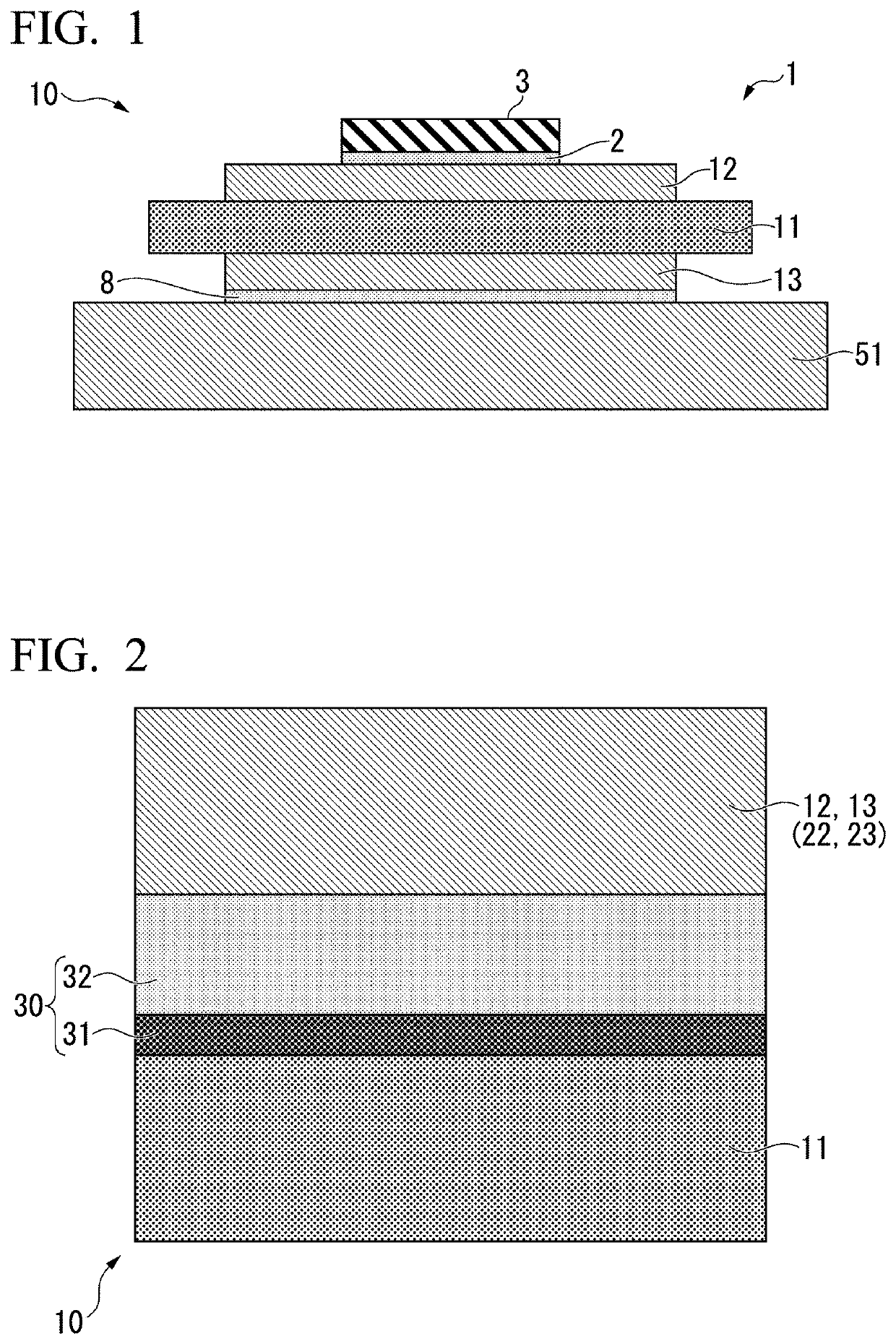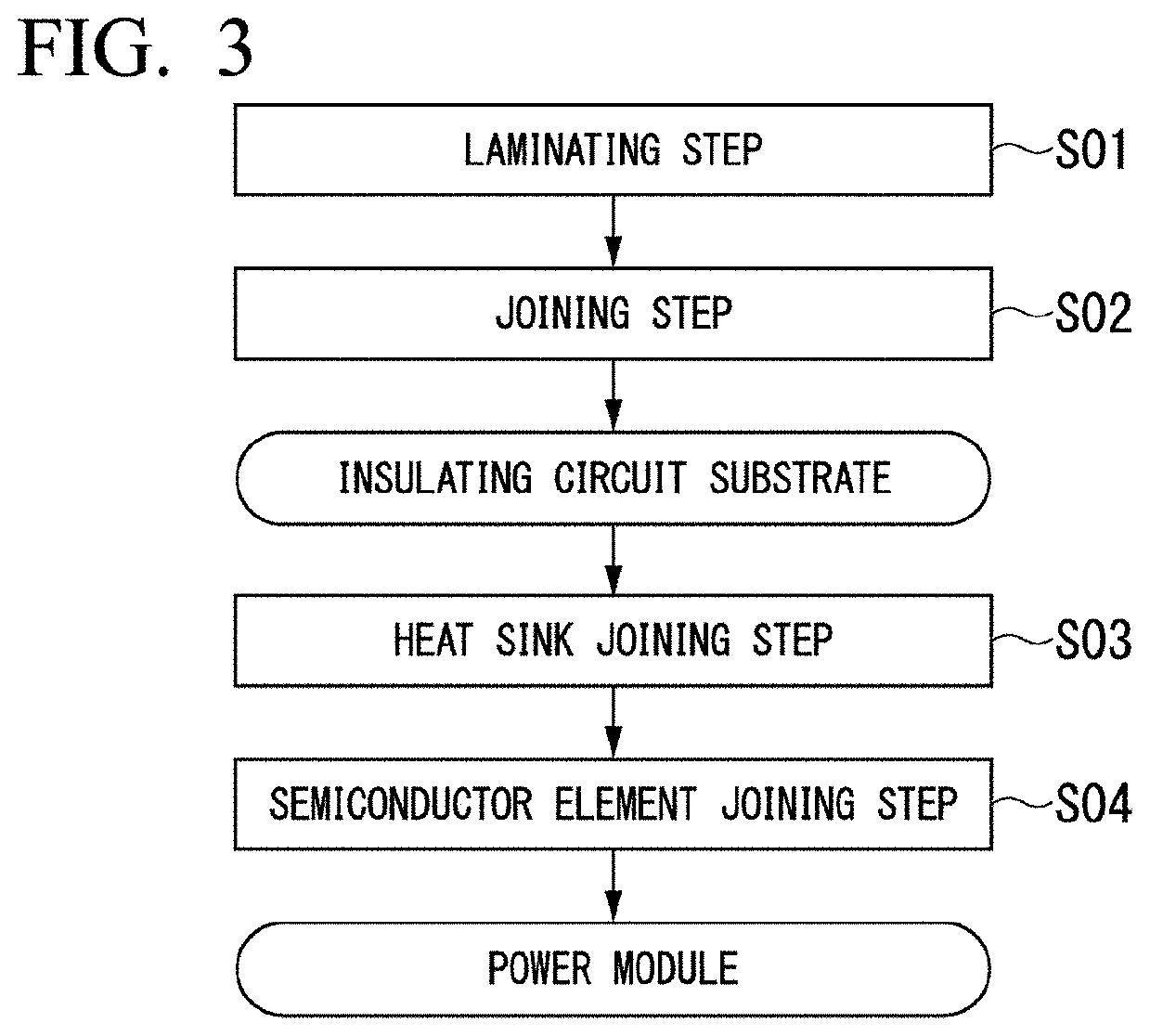Bonded body and insulating circuit substrate
- Summary
- Abstract
- Description
- Claims
- Application Information
AI Technical Summary
Benefits of technology
Problems solved by technology
Method used
Image
Examples
first embodiment
[0040]A description will be given below of a first embodiment of the present invention with reference to FIG. 1 to FIG. 4.
[0041]The bonded body according to the embodiment of the present invention is an insulating circuit substrate 10 configured by joining a ceramic substrate 11 as a ceramic member formed of Si-based ceramics and a copper sheet 22 (circuit layer 12) as a copper member formed of copper or a copper alloy. Here, the Si-based ceramics refer to ceramics formed of a compound including an Si element.
[0042]FIG. 1 shows the insulating circuit substrate 10 which is an embodiment of the present invention and a power module 1 using the insulating circuit substrate.
[0043]The power module 1 is provided with the insulating circuit substrate 10, a semiconductor element 3 joined via a first solder layer 2 to one side (upper side in FIG. 1) of the insulating circuit substrate 10, and a heat sink 51 arranged via a second solder layer 8 on the other side (the lower side in FIG. 1) of t...
second embodiment
[0092]Next, a description will be given of a second embodiment of the present invention. In addition, the same reference numerals are used in the description where the configuration is the same as the first embodiment and detailed description thereof is omitted.
[0093]FIG. 5 shows a power module 101 provided with an insulating circuit substrate 110 according to the second embodiment of the present invention.
[0094]The power module 101 is provided with the insulating circuit substrate 110, the semiconductor element 3 joined via the solder layer 2 to one surface (the upper surface in FIG. 5) of the insulating circuit substrate 110, and the heat sink 51 joined to a lower side of the insulating circuit substrate 110.
[0095]As shown in FIG. 8, a circuit layer 112 is formed to configured to join a copper sheet 122 formed of copper or a copper alloy to one surface of the ceramic substrate 11. In the present embodiment, a rolled plate of oxygen-free copper is used as the copper sheet 122 formi...
example 1
[0136]A copper sheet (6 mm×6 mm×0.3 mm thickness) formed of oxygen-free copper is sequentially laminated using a brazing material and an active metal material described in Table 1 on one surface of a ceramic substrate (26 mm×26 mm×0.32 mm thickness) formed of the material shown in Table 1 to form a laminate.
[0137]Then, the laminate was put into a vacuum heating furnace in a state of being pressed under the load shown in Table 2, and heated to join a copper sheet to one surface of the ceramic substrate. The heating temperature and time were as shown in Table 2.
[0138]In the manner described above, the joint bodies of the Examples of the present invention and the Comparative Examples were obtained. For the obtained joint bodies, the “Material and Crystallinity of Active Metal Compound Layer” and the “Ultrasonic Wave Joining Property” were evaluated.
[0139](Material and Crystallinity of Active Metal Compound Layer)
[0140]Measurement was carried out using a transmission electron microscope...
PUM
| Property | Measurement | Unit |
|---|---|---|
| Thickness | aaaaa | aaaaa |
| Thickness | aaaaa | aaaaa |
| Temperature | aaaaa | aaaaa |
Abstract
Description
Claims
Application Information
 Login to View More
Login to View More - R&D
- Intellectual Property
- Life Sciences
- Materials
- Tech Scout
- Unparalleled Data Quality
- Higher Quality Content
- 60% Fewer Hallucinations
Browse by: Latest US Patents, China's latest patents, Technical Efficacy Thesaurus, Application Domain, Technology Topic, Popular Technical Reports.
© 2025 PatSnap. All rights reserved.Legal|Privacy policy|Modern Slavery Act Transparency Statement|Sitemap|About US| Contact US: help@patsnap.com



